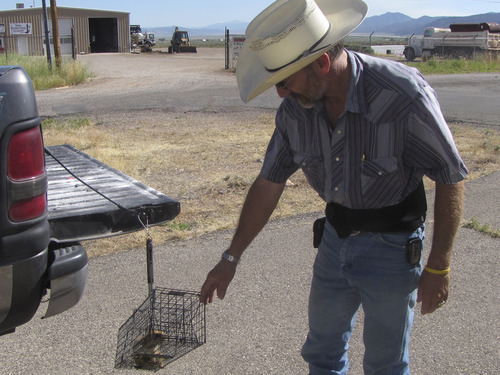This is an archived article that was published on sltrib.com in 2011, and information in the article may be outdated. It is provided only for personal research purposes and may not be reprinted.
Parowan • Like many people in Iron County, Dennis Gaede doesn't like Utah prairie dogs. So the Parowan city councilman is doing his part to capture the furry critters so they can be relocated far from his town.
But a recent attempt by Gaede and other trained volunteers to catch and remove the rodents from the Parowan Airport backfired.
Gaede was incensed to hear that 19 of 25 prairie dogs trapped and removed from the airport in mid-July were returned to their burrows.
"We were fit to be tied," said Gaede, who had left for the day when the creatures were returned.
Through July and August, Gaede and other volunteers will arrive at the airport Mondays through Thursdays at 6 a.m. and trap the animals until 11 a.m. They are kept in a ventilated shed until the Division of Wildlife Resources picks up the prairie dogs, which are listed by the U.S. Fish and Wildlife Service as a threatened species. The animals are taken back to Cedar City to be weighed, tagged and have their sex determined, then transported to relocation sites in Garfield, Wayne and Iron counties in hopes they will establish self-sustaining populations.
The relocation is part of a 20-year habitat conservation plan that requires the captured animals to weigh at least 500 grams (slightly more than 17.5 ounces) before they can be relocated. Those weighing less must be set free at the capture sites.
In addition to the airport, prairie dogs are trapped in the cemeteries in Paragonah and Cedar City. They are also being captured at the golf course and some public baseball fields in Cedar City.
Gaede said some of the animals lose weight during the process and maintains that officials are so strict with the weight requirement that the program will never succeed in lessening the impact the creatures have on development. He said the prairie dogs' threatened listing has cost Parowan dearly by hindering that development.
"The program has cost millions of dollars, and for what?" he wondered.
Adam Kavalunas, a DWR wildlife biologist and administrator of the Habitat Conservation Plan for the animal, agreed that some people at the airport were not pleased when he showed up to release the captured, underweight dogs.
"There was some heckling, but we just walked away," Kavalunas said.
He said the day after the critters were returned, Gaede called to ask why so many were considered underweight.
Kavalunas said he told Gaede he had to follow rules established by the Fish and Wildlife Service. Kavalunas said it happens rarely and praised the volunteers for their efforts.
He also said he hoped he did not leave Gaede with the impression that the volunteers were incompetent and needed additional training.
"They do a good job," said Kavalunas, adding there is some wiggle room if the weight is a little below the required amount.
"But not if they are only 300 to 400 grams, like some of them were," he said.
Airport manager David Norwood, who also operates a business with a partner at the facility, said there was a verbal confrontation but nothing serious.
He was disappointed to see prairie dogs returned, and like Gaede, is pessimistic that the program will clear the way for future development, especially at the airport.
He is also concerned about safety at the airport, where prairie dogs sometimes burrow beneath the asphalt landing strip, weakening its surface and forcing the city to monitor and repair the damage.
"Some [pilot] could be killed if a wheel collapsed in a hole poked in the asphalt," Norwood said.
Kavalunas' boss, DWR wildlife biologist Keith Day, said he met with both men after the airport incident.
"There were some ruffled feathers and a heated discussion," Day said. He emphasized that the meeting ended with the decision that there is no need for additional volunteer training.
"There is no point in blaming anybody and pointing fingers," Day said. "The [volunteer] program frees up [DWR] workers."
He said the agency is required to follow Fish and Wildlife Service rules and defended the release of the underweight animals back at the airport.
"The Fish and Wildlife Service has the final say," Day said. "If we start fudging, we have to with everything."
Prairie dog facts
What • Belongs to the family of rodents that includes squirrels, chipmunks and marmots
Size • 9.8 to 15.7 inches in length; 1.4 to 3.1 pounds
Diet • Mostly plants, but some insects
Habits • Prairie dogs live in clans of one male, several females and offspring
Source: U.S. Fish and Wildlife Service



